Nursing Case Study: Sharon Griggs - Non-Invasive Ventilation and Care
VerifiedAdded on 2022/12/19
|6
|1228
|73
Case Study
AI Summary
This case study examines the complex case of Sharon Griggs, focusing on the factors determining the success of non-invasive ventilation, including respiratory rate, acidosis, and premorbid conditions. The assignment explores the interventions of a multidisciplinary team, highlighting the importance of a nutritionist, oral hygiene, and proper feeding techniques to prevent aspiration pneumonia. It also discusses the significance of primary and secondary surveys, patient consent, and risk assessment in patient care. The author reflects on the expected outcome, the handling of the situation, and the importance of considering the patient's advance care directive. The case study emphasizes the importance of systemic approaches in patient care and the need for a multidisciplinary team. The case study also explores key learning points regarding primary and secondary surveys, education, and consent for NIV, as well as the overall care of the patient. The author reflects on the expected outcome and the handling of the situation, emphasizing the importance of considering the patient's requests outlined in the Advance Care Directive.

Sharon Griggs Case study 1
Sharon Griggs Case Study
By (Name)
The Name of the Class
Professor
The Name of the School
The City and State
The Date
Sharon Griggs Case Study
By (Name)
The Name of the Class
Professor
The Name of the School
The City and State
The Date
Paraphrase This Document
Need a fresh take? Get an instant paraphrase of this document with our AI Paraphraser
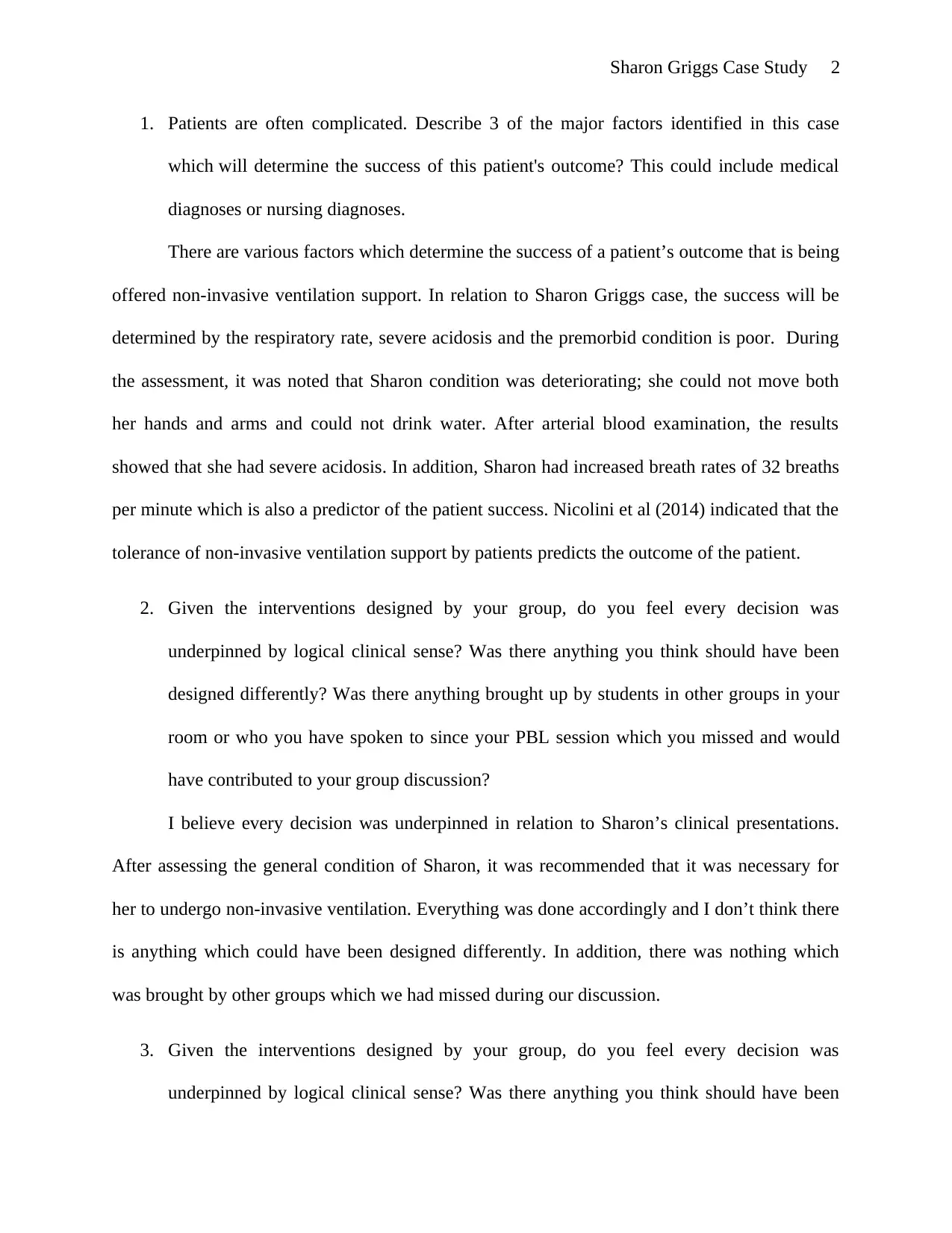
Sharon Griggs Case Study 2
1. Patients are often complicated. Describe 3 of the major factors identified in this case
which will determine the success of this patient's outcome? This could include medical
diagnoses or nursing diagnoses.
There are various factors which determine the success of a patient’s outcome that is being
offered non-invasive ventilation support. In relation to Sharon Griggs case, the success will be
determined by the respiratory rate, severe acidosis and the premorbid condition is poor. During
the assessment, it was noted that Sharon condition was deteriorating; she could not move both
her hands and arms and could not drink water. After arterial blood examination, the results
showed that she had severe acidosis. In addition, Sharon had increased breath rates of 32 breaths
per minute which is also a predictor of the patient success. Nicolini et al (2014) indicated that the
tolerance of non-invasive ventilation support by patients predicts the outcome of the patient.
2. Given the interventions designed by your group, do you feel every decision was
underpinned by logical clinical sense? Was there anything you think should have been
designed differently? Was there anything brought up by students in other groups in your
room or who you have spoken to since your PBL session which you missed and would
have contributed to your group discussion?
I believe every decision was underpinned in relation to Sharon’s clinical presentations.
After assessing the general condition of Sharon, it was recommended that it was necessary for
her to undergo non-invasive ventilation. Everything was done accordingly and I don’t think there
is anything which could have been designed differently. In addition, there was nothing which
was brought by other groups which we had missed during our discussion.
3. Given the interventions designed by your group, do you feel every decision was
underpinned by logical clinical sense? Was there anything you think should have been
1. Patients are often complicated. Describe 3 of the major factors identified in this case
which will determine the success of this patient's outcome? This could include medical
diagnoses or nursing diagnoses.
There are various factors which determine the success of a patient’s outcome that is being
offered non-invasive ventilation support. In relation to Sharon Griggs case, the success will be
determined by the respiratory rate, severe acidosis and the premorbid condition is poor. During
the assessment, it was noted that Sharon condition was deteriorating; she could not move both
her hands and arms and could not drink water. After arterial blood examination, the results
showed that she had severe acidosis. In addition, Sharon had increased breath rates of 32 breaths
per minute which is also a predictor of the patient success. Nicolini et al (2014) indicated that the
tolerance of non-invasive ventilation support by patients predicts the outcome of the patient.
2. Given the interventions designed by your group, do you feel every decision was
underpinned by logical clinical sense? Was there anything you think should have been
designed differently? Was there anything brought up by students in other groups in your
room or who you have spoken to since your PBL session which you missed and would
have contributed to your group discussion?
I believe every decision was underpinned in relation to Sharon’s clinical presentations.
After assessing the general condition of Sharon, it was recommended that it was necessary for
her to undergo non-invasive ventilation. Everything was done accordingly and I don’t think there
is anything which could have been designed differently. In addition, there was nothing which
was brought by other groups which we had missed during our discussion.
3. Given the interventions designed by your group, do you feel every decision was
underpinned by logical clinical sense? Was there anything you think should have been
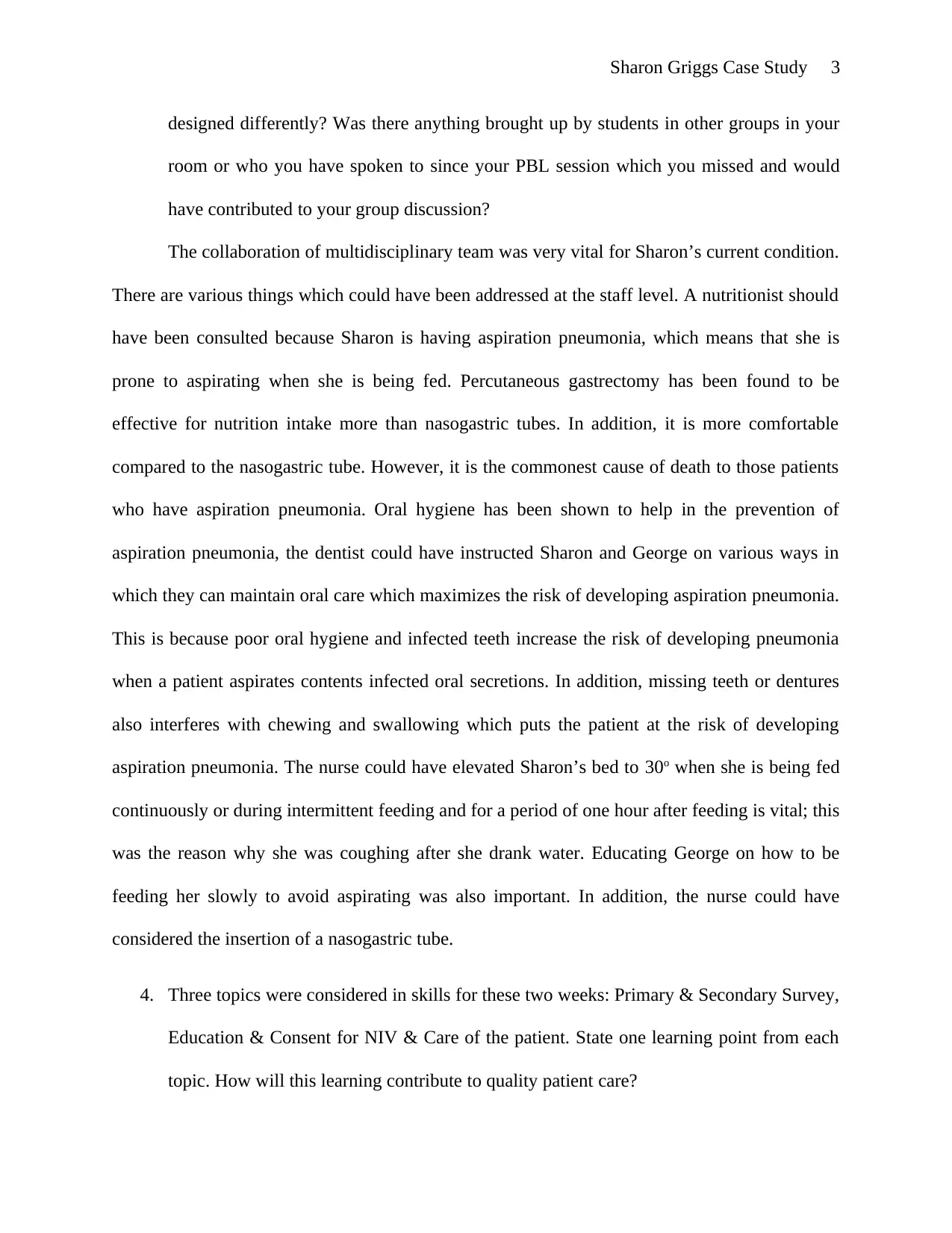
Sharon Griggs Case Study 3
designed differently? Was there anything brought up by students in other groups in your
room or who you have spoken to since your PBL session which you missed and would
have contributed to your group discussion?
The collaboration of multidisciplinary team was very vital for Sharon’s current condition.
There are various things which could have been addressed at the staff level. A nutritionist should
have been consulted because Sharon is having aspiration pneumonia, which means that she is
prone to aspirating when she is being fed. Percutaneous gastrectomy has been found to be
effective for nutrition intake more than nasogastric tubes. In addition, it is more comfortable
compared to the nasogastric tube. However, it is the commonest cause of death to those patients
who have aspiration pneumonia. Oral hygiene has been shown to help in the prevention of
aspiration pneumonia, the dentist could have instructed Sharon and George on various ways in
which they can maintain oral care which maximizes the risk of developing aspiration pneumonia.
This is because poor oral hygiene and infected teeth increase the risk of developing pneumonia
when a patient aspirates contents infected oral secretions. In addition, missing teeth or dentures
also interferes with chewing and swallowing which puts the patient at the risk of developing
aspiration pneumonia. The nurse could have elevated Sharon’s bed to 30o when she is being fed
continuously or during intermittent feeding and for a period of one hour after feeding is vital; this
was the reason why she was coughing after she drank water. Educating George on how to be
feeding her slowly to avoid aspirating was also important. In addition, the nurse could have
considered the insertion of a nasogastric tube.
4. Three topics were considered in skills for these two weeks: Primary & Secondary Survey,
Education & Consent for NIV & Care of the patient. State one learning point from each
topic. How will this learning contribute to quality patient care?
designed differently? Was there anything brought up by students in other groups in your
room or who you have spoken to since your PBL session which you missed and would
have contributed to your group discussion?
The collaboration of multidisciplinary team was very vital for Sharon’s current condition.
There are various things which could have been addressed at the staff level. A nutritionist should
have been consulted because Sharon is having aspiration pneumonia, which means that she is
prone to aspirating when she is being fed. Percutaneous gastrectomy has been found to be
effective for nutrition intake more than nasogastric tubes. In addition, it is more comfortable
compared to the nasogastric tube. However, it is the commonest cause of death to those patients
who have aspiration pneumonia. Oral hygiene has been shown to help in the prevention of
aspiration pneumonia, the dentist could have instructed Sharon and George on various ways in
which they can maintain oral care which maximizes the risk of developing aspiration pneumonia.
This is because poor oral hygiene and infected teeth increase the risk of developing pneumonia
when a patient aspirates contents infected oral secretions. In addition, missing teeth or dentures
also interferes with chewing and swallowing which puts the patient at the risk of developing
aspiration pneumonia. The nurse could have elevated Sharon’s bed to 30o when she is being fed
continuously or during intermittent feeding and for a period of one hour after feeding is vital; this
was the reason why she was coughing after she drank water. Educating George on how to be
feeding her slowly to avoid aspirating was also important. In addition, the nurse could have
considered the insertion of a nasogastric tube.
4. Three topics were considered in skills for these two weeks: Primary & Secondary Survey,
Education & Consent for NIV & Care of the patient. State one learning point from each
topic. How will this learning contribute to quality patient care?
⊘ This is a preview!⊘
Do you want full access?
Subscribe today to unlock all pages.

Trusted by 1+ million students worldwide
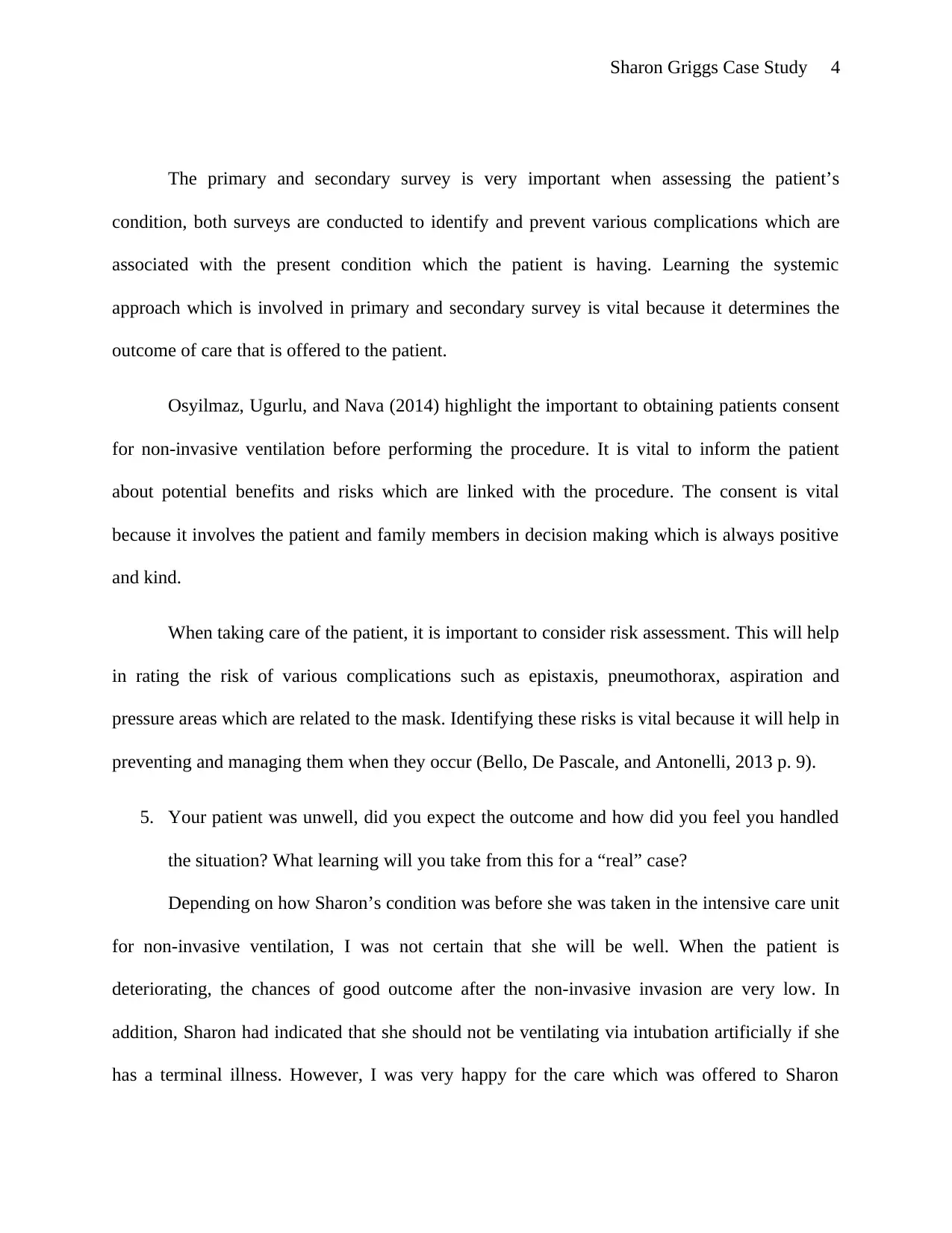
Sharon Griggs Case Study 4
The primary and secondary survey is very important when assessing the patient’s
condition, both surveys are conducted to identify and prevent various complications which are
associated with the present condition which the patient is having. Learning the systemic
approach which is involved in primary and secondary survey is vital because it determines the
outcome of care that is offered to the patient.
Osyilmaz, Ugurlu, and Nava (2014) highlight the important to obtaining patients consent
for non-invasive ventilation before performing the procedure. It is vital to inform the patient
about potential benefits and risks which are linked with the procedure. The consent is vital
because it involves the patient and family members in decision making which is always positive
and kind.
When taking care of the patient, it is important to consider risk assessment. This will help
in rating the risk of various complications such as epistaxis, pneumothorax, aspiration and
pressure areas which are related to the mask. Identifying these risks is vital because it will help in
preventing and managing them when they occur (Bello, De Pascale, and Antonelli, 2013 p. 9).
5. Your patient was unwell, did you expect the outcome and how did you feel you handled
the situation? What learning will you take from this for a “real” case?
Depending on how Sharon’s condition was before she was taken in the intensive care unit
for non-invasive ventilation, I was not certain that she will be well. When the patient is
deteriorating, the chances of good outcome after the non-invasive invasion are very low. In
addition, Sharon had indicated that she should not be ventilating via intubation artificially if she
has a terminal illness. However, I was very happy for the care which was offered to Sharon
The primary and secondary survey is very important when assessing the patient’s
condition, both surveys are conducted to identify and prevent various complications which are
associated with the present condition which the patient is having. Learning the systemic
approach which is involved in primary and secondary survey is vital because it determines the
outcome of care that is offered to the patient.
Osyilmaz, Ugurlu, and Nava (2014) highlight the important to obtaining patients consent
for non-invasive ventilation before performing the procedure. It is vital to inform the patient
about potential benefits and risks which are linked with the procedure. The consent is vital
because it involves the patient and family members in decision making which is always positive
and kind.
When taking care of the patient, it is important to consider risk assessment. This will help
in rating the risk of various complications such as epistaxis, pneumothorax, aspiration and
pressure areas which are related to the mask. Identifying these risks is vital because it will help in
preventing and managing them when they occur (Bello, De Pascale, and Antonelli, 2013 p. 9).
5. Your patient was unwell, did you expect the outcome and how did you feel you handled
the situation? What learning will you take from this for a “real” case?
Depending on how Sharon’s condition was before she was taken in the intensive care unit
for non-invasive ventilation, I was not certain that she will be well. When the patient is
deteriorating, the chances of good outcome after the non-invasive invasion are very low. In
addition, Sharon had indicated that she should not be ventilating via intubation artificially if she
has a terminal illness. However, I was very happy for the care which was offered to Sharon
Paraphrase This Document
Need a fresh take? Get an instant paraphrase of this document with our AI Paraphraser
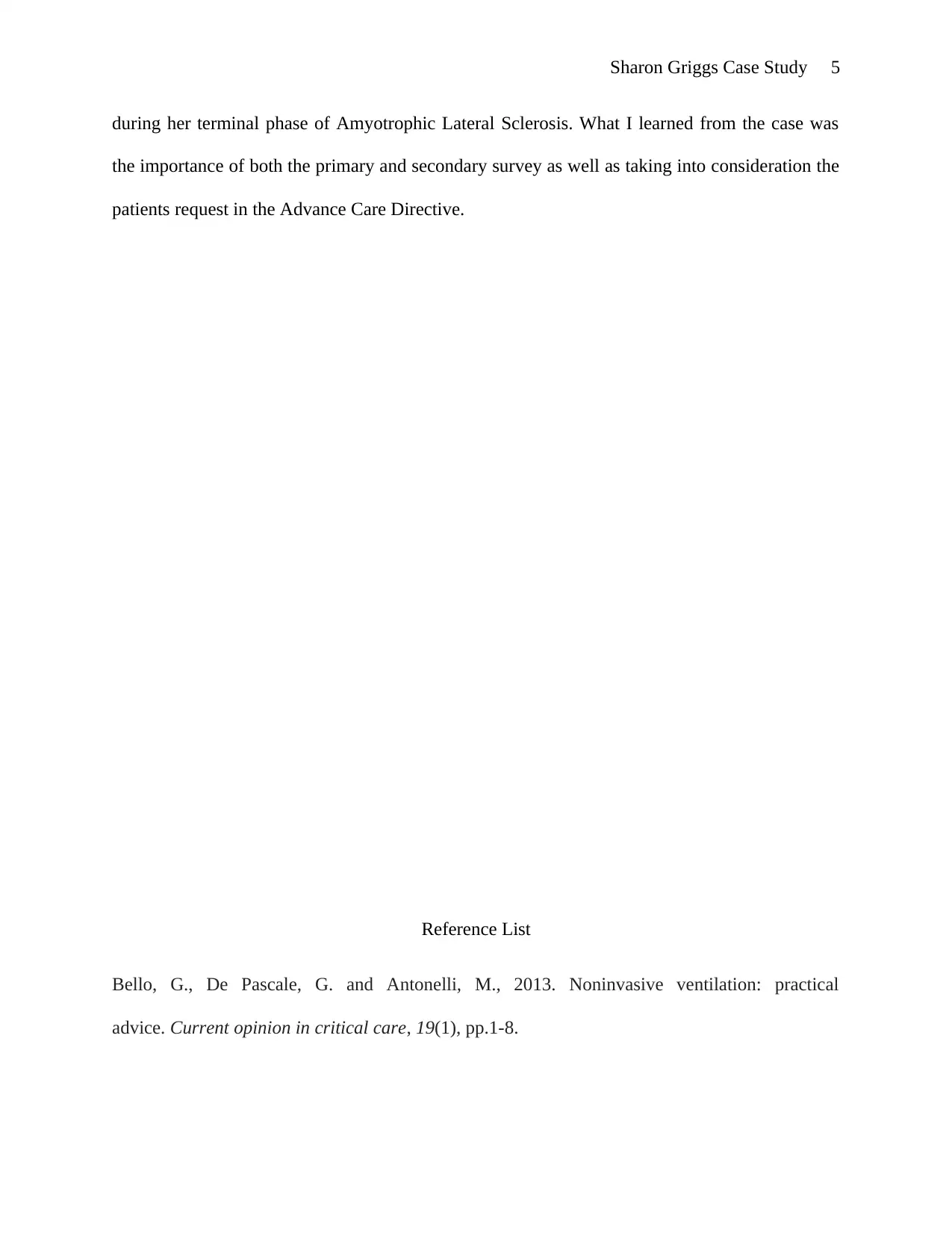
Sharon Griggs Case Study 5
during her terminal phase of Amyotrophic Lateral Sclerosis. What I learned from the case was
the importance of both the primary and secondary survey as well as taking into consideration the
patients request in the Advance Care Directive.
Reference List
Bello, G., De Pascale, G. and Antonelli, M., 2013. Noninvasive ventilation: practical
advice. Current opinion in critical care, 19(1), pp.1-8.
during her terminal phase of Amyotrophic Lateral Sclerosis. What I learned from the case was
the importance of both the primary and secondary survey as well as taking into consideration the
patients request in the Advance Care Directive.
Reference List
Bello, G., De Pascale, G. and Antonelli, M., 2013. Noninvasive ventilation: practical
advice. Current opinion in critical care, 19(1), pp.1-8.
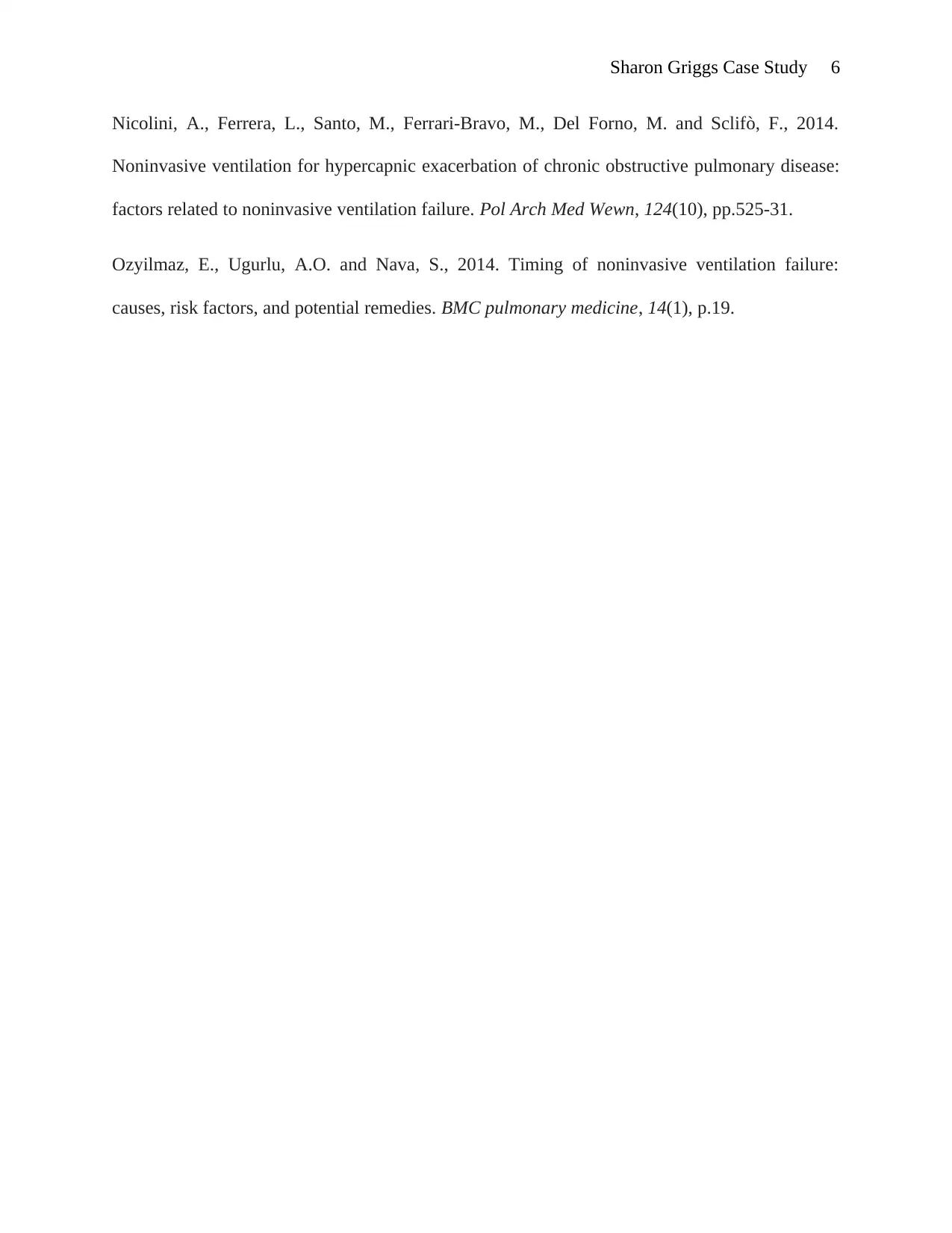
Sharon Griggs Case Study 6
Nicolini, A., Ferrera, L., Santo, M., Ferrari-Bravo, M., Del Forno, M. and Sclifò, F., 2014.
Noninvasive ventilation for hypercapnic exacerbation of chronic obstructive pulmonary disease:
factors related to noninvasive ventilation failure. Pol Arch Med Wewn, 124(10), pp.525-31.
Ozyilmaz, E., Ugurlu, A.O. and Nava, S., 2014. Timing of noninvasive ventilation failure:
causes, risk factors, and potential remedies. BMC pulmonary medicine, 14(1), p.19.
Nicolini, A., Ferrera, L., Santo, M., Ferrari-Bravo, M., Del Forno, M. and Sclifò, F., 2014.
Noninvasive ventilation for hypercapnic exacerbation of chronic obstructive pulmonary disease:
factors related to noninvasive ventilation failure. Pol Arch Med Wewn, 124(10), pp.525-31.
Ozyilmaz, E., Ugurlu, A.O. and Nava, S., 2014. Timing of noninvasive ventilation failure:
causes, risk factors, and potential remedies. BMC pulmonary medicine, 14(1), p.19.
⊘ This is a preview!⊘
Do you want full access?
Subscribe today to unlock all pages.

Trusted by 1+ million students worldwide
1 out of 6
Your All-in-One AI-Powered Toolkit for Academic Success.
+13062052269
info@desklib.com
Available 24*7 on WhatsApp / Email
![[object Object]](/_next/static/media/star-bottom.7253800d.svg)
Unlock your academic potential
Copyright © 2020–2025 A2Z Services. All Rights Reserved. Developed and managed by ZUCOL.


